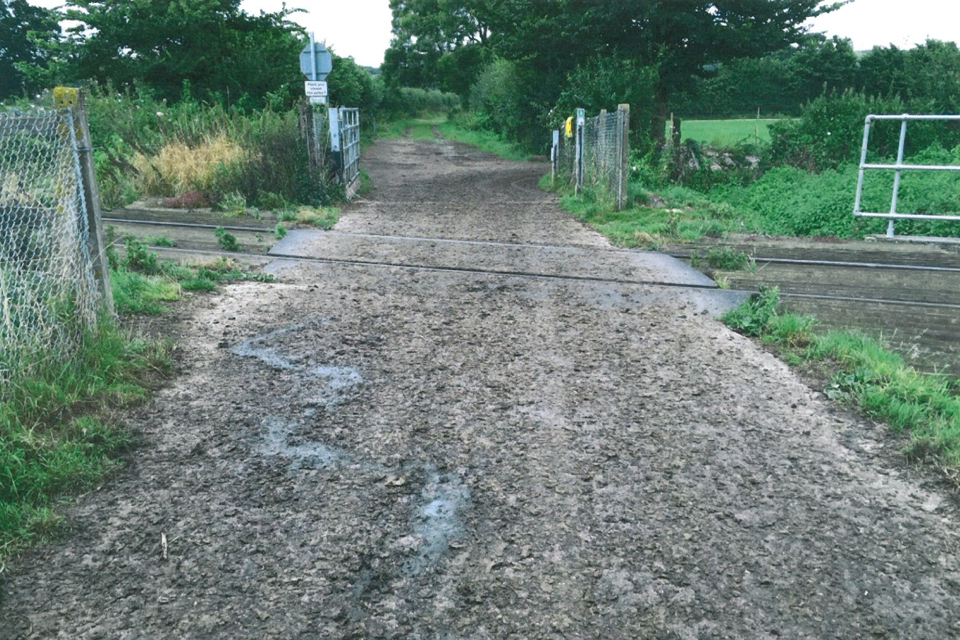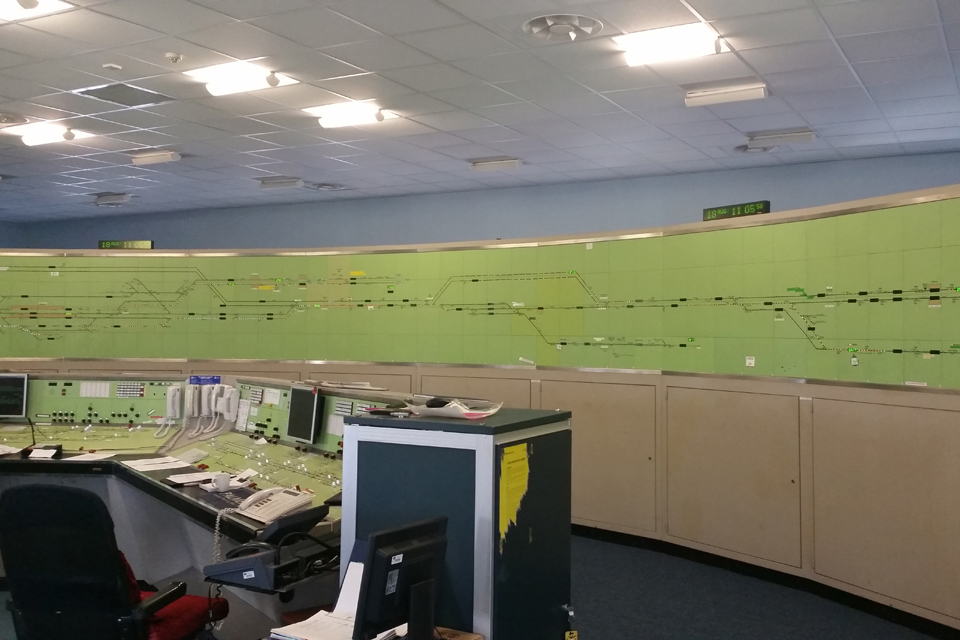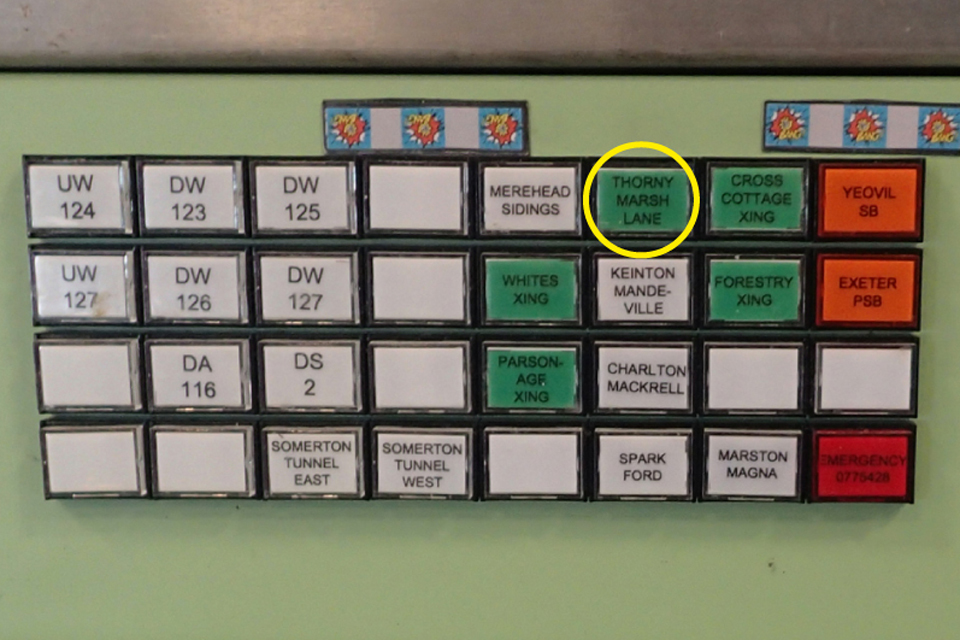Near miss at Thorney Marsh Lane level crossing, Castle Cary, Somerset, 26 November 2016
Published 25 January 2017
1. Important safety messages
This incident demonstrates the importance of:
- Signallers leading the conversation during phone calls from crossing users who may not be accustomed to safety critical communications, and
- Signallers fully considering and understanding the information available to them when deciding whether to give a crossing user permission to cross the line.
2. Summary of the incident
At 07:22 hrs on Saturday 26 November, a train almost collided with a tractor and trailer crossing the line at Thorney Marsh Lane user worked crossing (UWC). The tractor driver had been given permission to cross by the signaller. As he was crossing the line, the tractor driver saw the train approaching and accelerated his vehicle so as to clear the line before the train arrived. The forward facing CCTV pictures from the train show that the tractor and trailer cleared the line when the train was around 30 metres from the crossing. The train was travelling at 73 mph (117 km/h) at the time.
The train involved, 2O66, was the 06:47 hrs Great Western Railway passenger service from Westbury to Weymouth, formed of a 2-car class 150 diesel multiple unit. The train driver saw the tractor starting to cross, sounded the horn and applied the train’s emergency brake. The train came to a stand 450 metres past the crossing. The train driver and the tractor driver both called the signaller to report the near miss.

The gravel track at Thorney Marsh Lane level crossing (photo courtesy of Network Rail). The track crosses the railway line which runs from left to right. An open gate and warning sign are on the opposite side of the crossing with trees and fields beyond.
3. Cause of the incident
The crossing is equipped with a telephone and signs which instruct crossing users to call the signaller for permission to cross if they are crossing with vehicles or animals. The crossing telephone is connected to Westbury signal box where it is displayed along with other crossings in the area on a telephone concentrator panel.

The desk at Westbury signal box showing controls and telephone handsets. The large panels showing the signaller the various lines and signalling section run across the far wall from left to right.

Telephone concentrator on signaller’s control panel. showing thirty two push buttons labelled with different locations on the railway. The green button for Thorney Marsh Lane crossing is highlighted with a yellow circle.
The first call from the crossing that morning was at 05:45 hrs when the crossing user asked the signaller if he could cross back and forth for a period of time. The signaller on duty at that time was the night shift signaller and he checked when the next train was due and told the crossing user that he could use the crossing until 07:00 hrs, when he should call back.
The crossing user called back at 07:00 hrs and spoke to the day shift signaller. The user wanted to continue crossing the line and asked for permission to do this. The signaller told him that the next train was due to depart from Castle Cary at 07:14 hrs and that he could continue to cross but to call back before then.
The crossing user called the signaller at 07:09 hrs to say that he was ‘all clear for now’.
Train 2O66 was four minutes late leaving Castle Cary and had not passed the crossing when the crossing user called the signaller again at 07:21 hrs. The crossing user asked the signaller if the train had been through yet. However, the signaller appeared not to hear this correctly and assumed that, because the user was calling, the train must have passed the crossing. He had started to check the time that the next train was due when he was interrupted by the caller asking ‘can I cross or not’. The signaller continued to believe that the crossing user had seen the train pass, but he did not confirm with the user that this was the case. He checked the time the next train was due to pass and told the crossing user that he could cross and to call back at 07:30 hrs.
During the call the signaller looked at the display panel which showed that the Westbury to Weymouth train was occupying the section of track which starts approximately 2.4 km before the crossing and extends to a point approximately 12.8 km beyond the crossing. The display does not show the location of the train within this 15.2 km long section of track. For this reason, in order to give a user permission to cross when a train is in this section, the signaller must ask them if they have already seen the train pass the crossing.
Rule Book module G1 ‘General safety responsibilities and personal track safety for non-track workers’ defines responsibilities for safety critical communications in section 5 ‘Communications procedure’. This states that one person must always take lead responsibility in any conversation and that, with the exception of conversations between the signaller and the electrical controller, the signaller should take the lead in all conversations that he is involved in. However, the signaller did not lead the conversation with the crossing user when the user was asking for permission to cross.
4. Previous similar incidents
A collision occurred at Hockham Road UWC near Thetford on 10 April 2016. The signaller at Cambridge had given the crossing user permission to cross the line with a tractor when a train was approaching. The RAIB is investigating this accident and will publish a full report in early 2017.
A near miss occurred at Dock Lane UWC near Melton in Suffolk on 14 June 2016. The signaller at Saxmundham had given the crossing user permission to cross the line with a car when a train was approaching. The RAIB is investigating this incident and will publish a full report in spring 2017.
The RAIB has previously raised a concern about the risk at user worked crossings equipped with telephones within long signal sections. When users seek permission to cross at locations of this type, the signaller has no means of knowing the location of a train until a crossing user reports that it has passed. This can result in a signaller misjudging a train’s position, miscommunication between the signaller and crossing user, or an unusually long waiting time RAIB report 14/2011.
You can print this safety digest.

